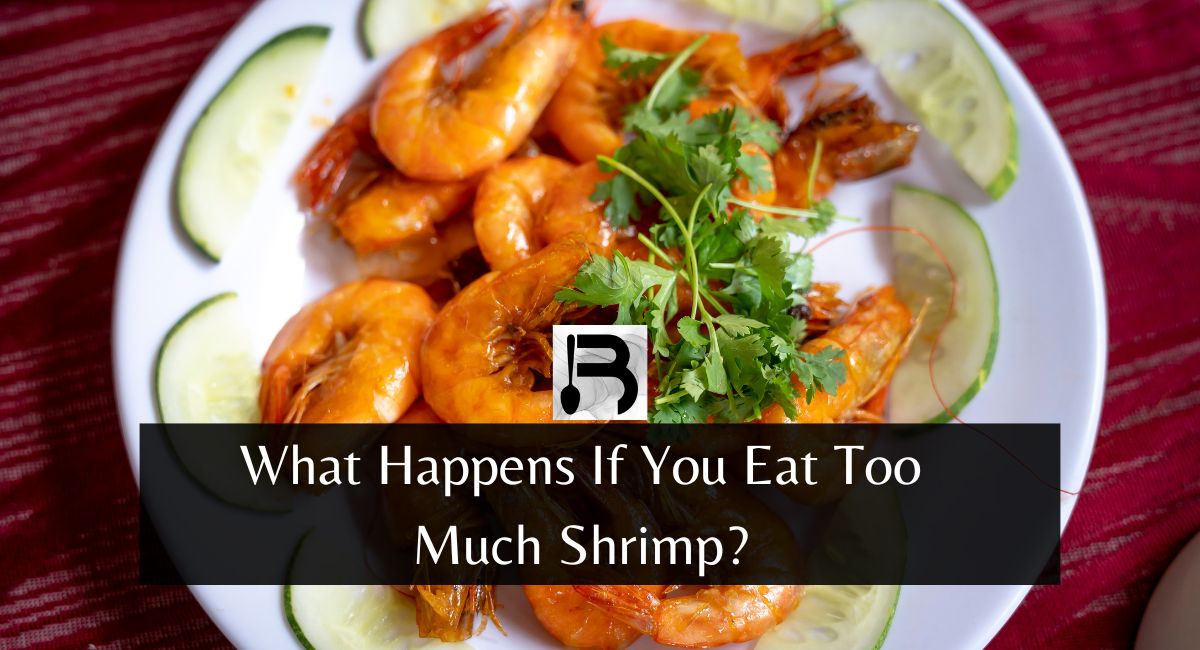Shrimp, a popular seafood delicacy enjoyed by many, is not only delicious but also packed with essential nutrients like protein, iodine, and omega-3 fatty acids. However, as with most foods, moderation is key.
Consuming shrimp in excessive amounts can lead to certain health implications, some of which are directly related to its natural constituents and others to how it’s sourced and prepared. So, what happens if you eat too much shrimp?
This article mentions the potential consequences of overindulging in shrimp and provides insights into the recommended consumption levels.
What Happens If You Eat Too Much Shrimp?
Eating too much shrimp or any food in excessive quantities can lead to various health issues. Shrimp itself is a nutritious seafood option when consumed in moderation, but overindulging can have negative consequences. Here are some potential problems that can arise from eating too much shrimp:
1. Cholesterol Content
One of the primary concerns about shrimp is its cholesterol content. A 3-ounce serving can contain as much as 200 milligrams of cholesterol. While dietary cholesterol doesn’t impact blood cholesterol levels for everyone, those sensitive to it might experience a spike in their LDL (bad) cholesterol levels.
2. Sodium Levels
Many shrimp products, especially those that are pre-cooked or processed, contain added salt, which can significantly increase your sodium intake. High sodium consumption is linked to hypertension (high blood pressure) and even an increased risk of heart disease.
3. Allergic Reactions
Some individuals are allergic to shellfish, including shrimp. Overconsumption can exacerbate allergic reactions, which can range from mild hives or a stuffy nose to severe anaphylaxis, a potentially life-threatening condition that requires immediate medical attention.
4. Heavy Metals and Pollutants
Shrimp, like many seafoods, can contain traces of heavy metals, such as mercury and other pollutants. While occasional consumption might not pose a significant risk, eating large quantities of shrimp regularly might lead to the accumulation of these toxins in the body.
5. Antibiotics and Chemical Residues
Some shrimp farms use antibiotics and chemicals to prevent disease and promote growth. Over time, these can accumulate in the body, potentially leading to antibiotic resistance and other health concerns.
6. Environmental Impact
Overconsumption of shrimp can also have environmental implications. Unsustainable shrimp farming practices can lead to mangrove deforestation, reduced biodiversity, and altered ecosystems. By consuming shrimp excessively, we indirectly contribute to these environmental issues.
7. Gout Flare-Ups
Shrimp contains purines, which are broken down into uric acid in the body. For individuals with gout, a type of inflammatory arthritis, excessive intake of purine-rich foods like shrimp can trigger painful flare-ups.
Is It Okay To Eat Shrimp Daily?
Eating shrimp daily provides protein, vitamins, and minerals. However, there are considerations:
- Cholesterol: Shrimp is high in cholesterol, but recent research suggests dietary cholesterol has a limited impact on blood cholesterol for most people.
- Mercury: Shrimp has low mercury levels compared to other seafood.
- Sustainability: Overfishing and farming practices can impact ecosystems. Choose sustainably sourced shrimp.
- Allergies: Some people are allergic to shellfish.
- Diversity: A varied diet ensures a range of nutrients.
Are Shrimps Healthier Than Chicken?
Shrimp and chicken both offer nutritional benefits:
- Protein: Both are excellent protein sources.
- Calories: Shrimp is lower in calories than chicken per serving.
- Cholesterol: Shrimp has more cholesterol, but dietary cholesterol’s impact on blood cholesterol is debated.
- Fats: Chicken, especially skin-on, has more fat.
- Omega-3s: Shrimp contains omega-3 fatty acids, beneficial for heart health.
- Vitamins/Minerals: Both provide essential nutrients, varying in types and amounts.
Neither is definitively “healthier”; each has its advantages. Consider overall diet and personal needs.
How Many Shrimps Can One Person Eat?
The number of shrimp one person can eat varies based on individual dietary needs and the size of the shrimp. Typically, a serving is 3-4 ounces, which equates to about 6-8 large shrimps. While shrimp is low in calories, allowing for more generous portions, it’s essential to be mindful of potential allergies, as some individuals are allergic to shellfish.
Additionally, when consuming shrimp regularly, it’s advisable to choose sustainably sourced options to minimize environmental impact. As with any food, moderation and balance with other dietary components are key.
Bottom Line
While shrimp offers numerous health benefits, excessive consumption can lead to potential concerns such as high cholesterol intake, exposure to harmful contaminants, and allergic reactions.
It’s essential to be mindful of portion sizes, sourcing, and preparation methods to enjoy shrimp’s benefits without the associated risks. As always, balance and variety in one’s diet are crucial for optimal health.
Read This Too: What Does Coconut Water Do To The Body?

